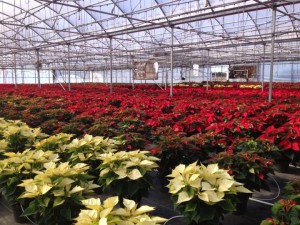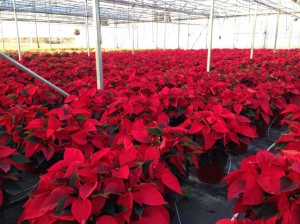The poinsettia is a beautiful plant associated with the Christmas holidays. These plants create colorful holiday decorations for any home. After the holidays are over, they can be used as landscape plants.
Poinsettias are non-poisonous and non-toxic. However, some people may be sensitive to the latex in poinsettia sap. Although eating even a large number of leaves will not result in illness, the plant is not considered edible. When used as an indoor plant, it should be kept out of reach of children and pets.
Keep your poinsettias away from drafts and chilly air. Water your poinsettia when the surface of the soil is dry to the touch. Place a saucer under the pot, and drain the saucer if water starts to collect in it. Keep the soil from getting soggy. Gently spray the plants with a mist sprayer or place them on gravel trays. Slightly humid air will help prolong the plants’ color and life span. Do not fertilize your indoor poinsettias until you are ready to move them outside. High levels of fertilizer will reduce the quality of the plant.
When the temperatures start to warm up in spring, trim the fading bracts. Leave 4 to 6 inches of the stem on each branch. Begin using a well-balanced fertilizer, and move the plant outdoors to a somewhat shaded area. Once the poinsettia has acclimated to the outdoors, plant it in an area that receives full sun most of the day. Keep in mind that to put out its colorful bracts, poinsettias require 14 hours of complete darkness each day for 6 to 8 weeks. Any interruption to this dark period can delay or prevent the plant from flowering.
Keep the soil moderately moist at all times. Poinsettias grow best in moist, well drained, fertile soils. The ideal soil pH range is 5.5 to 6.5, but the plants will tolerate a range from 5.0 and 7.0. Fertilize your outdoor poinsettias once a month. In north Florida, the plants should be fertilized between May and September.
In the landscape, prune your poinsettias in early spring after they are finished blooming, and when the danger of frost has passed. Cut them back to within 12 to 18 inches of the ground. If the plants have been frozen below this point, cut them back to the live wood. Pruning during the growing season will produce a compact plant at flowering time. After four weeks or when the new growth is 12 inches long, cut the plant back, leaving four leaves on each shoot.
For more information see: Poinsettias at a Glance
- Vegetable Garden Insect and Disease Management - June 10, 2015
- Insect Problems in the Heat of Summer - May 8, 2015
- Gardening in a Bucket - April 14, 2015


